Idea: A sign at the top of Mt. Everest
[This post is part of an idea dump.]
Is anyone heading up Mt. Everest soon? I have an idea. Put a sign at the top for future travelers that says “Thank you Mario! But our princess is on another mountain!”
Filed under “Games”

[This post is part of an idea dump.]
Is anyone heading up Mt. Everest soon? I have an idea. Put a sign at the top for future travelers that says “Thank you Mario! But our princess is on another mountain!”

Preface

SpellTower Champ JerryMy father-in-law Jerry is great at word puzzles. He’s a retired economist for the FTC with a passion for music and a life-long interest in math and science. He says he dabbles in games and puzzles “occasionally for relaxation,” but that understates his skill. At family gatherings, he wins practically every game of Scrabble, Boggle, Bridge, you name it.
Over the holidays, I showed him SpellTower on my iPad. The game combines elements of Boggle and Tetris, and I thought he would enjoy it. By the time I took my iPad back at the end of the trip, he had already broken the SpellTower “Puzzle Mode” record on the Game Center leader board by almost 100,000 points (and shattered my high score of 17,876 which I thought was pretty good). He still has the high score on the leader board with 167,275 points.
Like most people who play the game once, he was hooked, so he bought SpellTower for his own iPad. The other day he told me that he’s been playing the same continuous game for over a month now and has obliterated his own high score. He has passed 1,000,000 points, adding about 20,000 points a day. He’s confident he can keep playing as long as he wants. (His score won’t show up in Game Center until he ends the game).
On Jerry’s behalf, I bragged to SpellTower creator Zach Gage via Twitter. Zach replied, “Holy [expletive]. He is a beast. I want to know his strategy.”
So I asked Jerry if he would share his strategy. Some of it may seem obvious, and some of it you may not have considered, but here it is in full, explained in his own words in this blog’s very first Guest Post:
How I Scored A Million Points In SpellTower
The key to getting a high score is patience. Don’t play too fast, and don’t feel that you have to enter a word just because you found it. There is no problem in letting several turns go by without making any words at all — that just gives you a bigger collection of letters and more choices.

Approaching one million pointsThe main strategic principle is to avoid developing towers on the sides of the board. Instead, try to cultivate a shape in which the board is even, or better yet, shaped like an upside down U where the middle columns are higher than the sides. The reason for this is simple: the side rows are the hardest to clear because there are fewer possible words to make when you can connect to letters on just one side. So always look first for words that use letters in the extreme side columns. If you can’t find any, just add another row until you can. Always enter the letters one by one until the board displays exactly which letters will be removed. Then examine the effect it will have on your shape before you hit the last letter a second time to enter the word. Look before you leap.
The next principle is to make long words rather than short ones. The obvious advantage is that you clear more letters, since five (or more) letter words clear all adjoining squares. You also avoid selectively removing the letters with no nasty little 6’s in the corners, creating a board in which most of the remaining letters do have these nasty 6’s. Yet another advantage is that you save the short, common words for an emergency. If you quickly use up many of the three letter words, you won’t have those words left to help you when they are the only way to save you from death. So again, if you can’t find a long word, it is usually better to add a row of letters than to make a 3 or 4 letter word. Save the short ones for emergencies and to help cut down pesky little towers or accumulations of black spaces before they get out of control. Even more important: save up the short J, X, Q, and Z words, because they are really helpful in a jam.
There is one more special technique that is handy when you really need it. Sometimes you just can’t find any word, and you are close to death. Rather than taking a chance with getting good letters in your next row, you can sometimes find a word which is almost connected, but not quite. By making a short word that removes a letter or two that is in the way, you can sometimes connect the word and use it in your next turn to clear out a critical column.
I haven’t said anything about how to find words — this is an issue common to all of these words games, most notably Boggle. Just use the same strategies, such as keeping an eye out for common sequences such as ER, ING, ION, etc., and keep trying different shapes and possibilities.
And one more thing — don’t be afraid to guess. No matter how many words you know, there are thousands of other words that SpellTower recognizes that you have never heard of before. So if you are in a jam, just press in any plausible sequence of letters, and you will find that a surprising number of them are accepted as words.
It really all comes down to patience. Never make a word just because the word has a high score. One word is worth nothing. Staying alive is everything. If adding an S to your word gives you another 100 points but makes your shape worse, leave out the S! If you find a 6 letter word that increases the size of a side tower by 1, spend a little more time and try to find a different one that has a better effect on your shape. If you find a great word that gives you 1000 points but eats up the middle of the board, you are just tempting fate. In fact, if you are playing the regular puzzle mode, there is no need to die. The only thing that would be guaranteed to do you in is that eventually you will use up so many words that there won’t be enough left. But even that is not a problem, because I have discovered that the memory cache for the words already used is too small, so that if you play long enough, you can start using the same words a second or third time. This starts kicking in after you have amassed about 600,000 points. But to get there, you really need patience!

[cross-posted from my photography blog]
Ralph Baer, the father of video games, turns 90 years old on Thursday. One of his early inventions, the Magnavox Odyssey, was the first home video game system. It turns 40 years old this year. I photographed and interviewed Ralph over the summer for my ongoing Inventor Portraits Project, and this seemed like a good time to share some of the video in which we discuss, among other things, why he’s still inventing at 90 years old.
At one point in our interview he expressed frustration that modern kids don’t read anymore because they’re too busy playing with their smartphones. So I asked him if he thinks kids play too many video games today. Did he accidentally unleash a monster with his invention? His answer:
Yeah. I did a bit. What I thought I unleashed was a family game. If you’ll stop to consider for a second, what’s the ping pong game? You can’t play ping pong with yourself. It was meant to be played by two people. And we had four-handed ping pong and hockey games early on, also. I always thought of it as a family game. And it just sort of degenerated into a one player type thing which was never in my mind.
I thought that was interesting. I think I see a pendulum swinging back in Baer’s direction with consoles like the Nintendo Wii, which put an emphasis on group play.
Anyway, Happy 90th Birthday, Ralph!


One of the most popular items you can buy for babies right now is Sophie, a teething toy shaped like a giraffe. There were more Sophie giraffes purchased last year in France, where Sophie originated, than there were babies born. This market needs to be tapped. And that’s why I propose a new line of teething toys shaped like characters from vampire stories.
What better thing is there for your baby to sink her new teeth into than a vampire victim?
As an example I’ve taken the character Jonathan Harker from Dracula and mocked up what he might look like as a teething toy:

Notice the curved arms for easy grasping, and lots of nubby bits for gnawing.
The line would start out with characters from Dracula since it’s public domain, but eventually expand to licensed characters like Sookie Stackhouse, Buffy, and that girl from the popular movies about the glittery vampire.

This has been on my “Ideas to post” list for what seems like a couple years already. I keep going back and forth between “I should just post it as an idea” and “No, I should actually make it a real thing.” And then I go back and forth between “This is a good idea” and “It’s not that good” with the occasional “Maybe it’s an annoying idea” thrown in for good measure.
Anyway, it’s been on my list so long that I think it’s time to get off the pot and just post it. So here it is:
You know how sometimes you get an automated tweet in response to something you wrote? It’s often spammy, but sometimes it’s something strange like @AllTheCheeses that retweets any time someone mentions cheeses. Or @thedreamstream that retweets anyone who talks about their dreams.
I came up with an idea to turn automated retweets like this into a game that’s actually played on Twitter.
I registered the username @twentywords. The idea was that @twentywords would automatically retweet anyone who used one of 20 secret words. By following @twentywords, you could try to figure out what the trigger words are. And the first person to reply to @twentywords with a list of all twenty words wins. Then a new bunch of words are picked and it starts all over. @Twentywords would follow the winners, keeping a running tally of who has won.
Most people wouldn’t know that @twentywords exists until they notice that it retweeted them. They’d wonder “Who is @twentywords and why is he or she retweeting that totally mundane thing I just wrote?” so they’d check out the profile. And in the profile it would explain that @twentywords is a game and explain the rules with a link to more info. It would start out slow but grow organically as more people happened to discover the game because they happened to be retweeted.
That was the idea. One problem I ran into was picking the words. If they’re too common, the account would go crazy retweeting, and it wouldn’t be difficult for people to scroll through the retweets to find the 20 words. And if they’re too obscure, the game would be impossible.
Also, it turns out that many uncommon words in everyday life are still pretty common on Twitter. With 175 million registered user, a lot of obscure words get used a lot.
See for yourself. Think of an uncommon-but-not-too-uncommon word, and do a Twitter search to see how many people used it today. Sarcophagus? Alveoli? See what I mean?
Hmm. Maybe I’ve accidentally stumbled upon a different game. Is there a Twitter equivalent of Googlewhacking?

 I still own two film cameras. One is a Mamiya medium format camera. The other is a 1950 Stereo Realist 35mm 3-D camera. I’ve been creating and consuming 3-D content since I was young, using every technique I could learn about, including some that most people have never seen. I’m a proponent of 3-D movies in theory, but am disappointed with most of the movies I’ve seen in the format’s current resurgence. I have so many thoughts on the matter — including why I’m fascinated by 3-D, where I’d like to see it go from here, and what I think of Roger Ebert’s (and others’) anti-3-D stance — that I’ve considered purging them all in one giant post. This is not that post.
I still own two film cameras. One is a Mamiya medium format camera. The other is a 1950 Stereo Realist 35mm 3-D camera. I’ve been creating and consuming 3-D content since I was young, using every technique I could learn about, including some that most people have never seen. I’m a proponent of 3-D movies in theory, but am disappointed with most of the movies I’ve seen in the format’s current resurgence. I have so many thoughts on the matter — including why I’m fascinated by 3-D, where I’d like to see it go from here, and what I think of Roger Ebert’s (and others’) anti-3-D stance — that I’ve considered purging them all in one giant post. This is not that post.
This post is just about the single best 3-D entertainment experience I ever had. I enjoyed it in the comfort of my own home, and it didn’t cost very much money. After watching the home video game console companies show off their 3-D games at last week’s Electronic Entertainment Expo, I thought I’d write about it, because my best 3-D experience was with 3-D gaming.
Ten years ago, I purchased a pair of Elsa Revelator 3-D Glasses for the PC. It cost me $34. The glasses connected to the computer with a thin wire that ran to a pass-through plug between the graphics card and the monitor. Combined with special software, it could turn any existing hardware-accelerated game into a true 3D experience using active shutter technology.
A quick definition of active shutter technology: an liquid crystal lens over each eye flickers between clear and opaque in sync with images onscreen that are rendered slightly offset for each eye. As long as the monitor refreshes quickly enough, the flicker is not noticeable, although the screen appears a bit dim. Since each eye only sees images rendered for one perspective, the brain perceives the image as 3-D.
 The first game I played in 3-D was Tomb Raider (natch). The border of my monitor suddenly became a window, and I was looking into Lara Croft’s world. She became a fully rounded Barbie-sized figure running around a tiny landscape, firing at enemies. It was amazing. There were some glitches with the technology — occasional flashes of light when the glasses would lose sync with the monitor, and odd 3-D artifacts where ripples in a pond were supposed to refract light — but I could see the potential in 3-D gaming already.
The first game I played in 3-D was Tomb Raider (natch). The border of my monitor suddenly became a window, and I was looking into Lara Croft’s world. She became a fully rounded Barbie-sized figure running around a tiny landscape, firing at enemies. It was amazing. There were some glitches with the technology — occasional flashes of light when the glasses would lose sync with the monitor, and odd 3-D artifacts where ripples in a pond were supposed to refract light — but I could see the potential in 3-D gaming already.
The glasses came packaged with a demo version of a game I’d never heard of called “Thief 2.” This was the game that blew me away.
Unlike Tomb Raider, where you see your character on screen, Thief 2 is played in first person perspective. Your character is a thief and, unlike most other games, you don’t just run around shooting enemies as quickly as you can. The idea is to be sneaky. You hide in the shadows, avoid being seen, and creep around villages and castles to complete each level.
I sat in front of the computer with 3-D glasses on and room lights off. I wore headphones for total immersion, and the game used sound to great effect. My character’s footsteps were often the only sounds I heard as I snuck around the virtual landscape. But if I listened carefully, I could hear when a guard was coming so I could make sure I wouldn’t be caught. In 3-D, the hallways and streets had depth. Buildings had form. It really felt like I was there, sneaking around. It felt almost real.
Here’s a sample of gameplay:
I purchased the full version of the game and played it from start to finish over the next couple weeks. I’m not that much of a gamer, but I’d never had a gaming experience that made my heart race so much, that really transported me into the game world. I’ve played virtual reality games with headgear-mounted goggles and motion tracking, but this was so much better.
I still remember clearly a level late in the game where I had to walk across a rafter high above the ground. When I looked down, I could actually see the distance I would fall to the floor below if I slipped. In 2-D, the thin beam of wood I was standing on would have been on the same plane as everything else on the screen. But this felt like a real beam of wood high above a real floor. I’d never been so nervous playing a game as I was in that moment.
I wanted to tell everyone to get these glasses. Why on Earth would anyone play games the old flat way? This is how games should be played! This should be mainstream! Why weren’t the video game consoles of the time making games that would work with the same technology?
The answer, in part, is that standard televisions didn’t have a high enough refresh rate to make the experience worthwhile. A slower refresh rate makes the flickering of active shutter glasses noticeable, which is very unpleasant. So 3-D games in home consoles would have to wait.
And now they’re coming. New TVs have high refresh rates, and console makers are taking advantage of that. The 3-D glasses no longer need to be tethered by a thin wire. They stay in sync wirelessly. But now that the technology has caught up, I’m not so sure everyone else will have the same amazing experience I had.
When I played Thief 2, I was a bachelor living by myself. I could turn out the lights, sit a couple feet from the screen, and totally immerse myself in the game without anyone caring. I think that’s a big reason why I was so sucked in. With a game console, the TV often sits on the other side of the living room, rather than right in front of your face. At that distance, the depth is a cool effect, but not an all-encompassing experience (unless it’s a very large TV).
I predict that people will respond to 3-D games in a segmented way depending on their circumstances. People who play alone without worrying about being antisocial will become immersed in first person shooters; they will be transported into the world of the game. People who play more socially or further from the screen will benefit from 3-D in a more subtle way; their experience will be similar to getting a new game console that can render graphics more realistically. It will be a cool special effect, but not a whole new way of experiencing a game. With the high cost of today’s wireless 3-D glasses, and the reluctance people may have to sit around wearing dark glasses indoors, I’m not optimistic that 3-D games will be huge any time soon outside the “bachelor” demographic.
Ten years after my experience with Thief 2, I still think of it as a benchmark for what 3-D gaming can be. But perhaps someone will come up with some new and unexpected use of 3-D in video games that will make me realize that Thief 2 was just a beginning, and that my experience ten years ago was the tip of the iceberg.
(I’m excited to see what’s offered for Nintendo’s upcoming 3-D glasses-free handheld console. I suspect that the 3-D screen is too small to really immerse you like I was with Thief 2, but is small enough that it could be used as an effective window into another world. The device is only experienced by one person at a time by design, and I think all these factors could inspire some very creative game experiences.)
Incidentally, while the Elsa Revelator glasses are no longer available, nVidia does sell a similar product (although it’s unfortunately more expensive). But if you’re a PC gamer, I highly recommend you give them a try.

The fighting genre of video games has some crossover titles like the Marvel vs Capcom series that pits Marvel Comics characters against fighters from Capcom’s games. So you could end up with Iron Man fighting a Street Fighter character, for example.
I’d like to see a crossover fighting game that pits characters from various HBO TV series against one another in fights to the death in locations from their shows.

You could have Ruth Fisher vs Larry David fighting on the set of Bill Maher’s show. Or pit Sookie Stackhouse against Rich Hall in the Sopranos’ kitchen. Or Wembley Fraggle vs Ali G in the Crypt Keeper’s crypt.
Everyone would have different strengths, weapons, and special attacks. Hank Kingsley’s all-powerful Hey Now of Death would inflict major damage, but he’d be vulnerable to the Dennis Miller Ravaging Rant and Tracey Ullman’s Go Home Grapple.
It’s a fight to the finish. There can HBOnly one.

It seems to be the consensus that Arial is a substandard alternative to Helvetica. But just how bad is it? What if the logos we’re used to seeing in Helvetica were redone in Arial? Would you even notice if the next time you saw the American Airlines logo it was redone in Arial? Here it is in both fonts. At a glance, can you tell which is which?


The top one is Arial. If you know what to look for, it probably jumped right out at you. If not, you may see that they’re different but still not know which is which.
To test your skills, and help you learn to recognize Arial vs Helvetica, I’ve taken 20 Helvetica logos and redone them in Arial. (Blasphemy!) A lot of them are just plain awful in Arial. But a couple of them are actually tough to tell apart.
You’ll get half of them right by just randomly guessing, but if you don’t do much better than that, here are some good resources for you to check out that will teach you the differences between Arial and Helvetica:
Link: How to Spot Arial
Link: Arial and Helvetica overlayed
Link: The Scourge of Arial

A couple years ago, I thought it would be fun to make an old school geeky Sierra-style adventure game using Adventure Game Studio. I got far enough to realize that it would take a lot more time (and probably skill) than I had to make it. But I did do some work sketching the game on paper in a spiral notebook which I happened to come across this week. I’ve scanned in some pages so I could show you the aborted adventure game I never made.
I hadn’t settled on a name for the game, but I thought about calling it “Blogosphere” or “Blogosfear” or “Blogosphear.” The opening animated narrative would introduce you to the protagonist “Dave” who was staying up late reading blogs instead of going to bed. Some sort of mishap (energy drink spilled on the computer?) was going to start a chain of events that digitally teleports him into the internet. The teleportation was going to look like Flynn being digitized in Tron.
So the gameplay begins with Dave finding himself materialized in a waiting room like one would find in a doctor’s office:

The only door, with a sign reading “Blogosphere,” is locked. But when Dave pulls a number from the “Take a Number” display, the receptionist’s window opens. The receptionist was to be played by Clippy the MS Office Paperclip, who has had to find other work since he’s no longer employed by Microsoft. Through witty interactive dialogue, Dave would protest that he doesn’t belong there and needs to get back home. Clippy would explain that once you’ve entered the blogosphere, the only way to cancel your account is to consult the Great and Powerful Eula. And this sets up your adventure to find Eula and learn how to get home. Clippy buzzes Dave through the door to start his adventure.
The next room is the BlingBling room:

This room has an airport-style metal detector which doesn’t allow anyone through to the blogosphere with anything in their pockets. The sign says “BlingBling: the Gateway to Wonderful Things.” The gateway is guarded by Cory Doctorno and Jenny Gardner. The walls are covered with banner ads for t-shirts. Dave turns over his belongings, which means he starts his adventure with nothing. Cory and Jenny explain that to find the Great and Powerful Eula, Dave should follow the Yellow Paved Road. He continues on his way.
The next screen reveals that the Yellow Paved Road isn’t very long. In fact, the Great and Powerful Eula’s place is right next door.

Eula is a big floating head, a la the Wizard of Oz, but I don’t remember why I gave him glasses. Anyway, he tells Dave that in order to get back home, he must bring Eula the broomstick (or something) of the Wiki Witch of the Web. That’s the real goal in the game.

This is a path away from Eula’s place. There’s a path to the right, but up ahead there’s a building in the distance that looks like it’s made out of giant forks.

It is made out of giant forks. It’s Fork.com.

Inside Fork.com you meet Drew Curtains. He sits on a throne of forks. He has chandeliers made out of forks. He’s kind of obsessed with forks. Somehow this would have figured into a puzzle.

Taking the other path would have brought you to this rundown shack. It’s Jason Tchochke’s place.

Inside, Tchochke’s place is full of shelves and shelves of various tchochkes. Somehow this would have figured into a puzzle.

Further along the path you would encounter the domain of the Wonkess. It’s supposed to be reminiscent of the White House.

Inside, the Wonkess sits at a desk in an oval office. I’m not sure exactly how, but somehow this would have figured into a puzzle.

Further still along the path lies a sign that says “Dig.” At first you can’t do anything here, but eventually you would find a shovel, and you could come back here to dig.

An animated cut scene would have simply shown you digging into the ground. It would either be visually similar to a scene from Dig Dug, or (as shown here) you would see the fossilized remains of video game characters buried in the ground.

Eventually you would break through to the underground lair of Kevin Rouse, wearing a backwards baseball cap and headphones. He was going to be a bit crazy, throwing piles of money in the air, since an article in BusinessGeek Magazine said he’s worth $60 million, so he took out a loan. In the background is the secret elevator that would take you back up to the grassy patch where you started digging.

This is PooTube. It’s a series of tubes. One of the tubes has a door on it. As you approach the door, a mechanic was going to pop out from behind a tube and tell you that you don’t want to go in there. He’s the character you interact with here. Not sure what he was going to say, though.

This is the entrance to Slashbot, a company that makes Robots for Nerds. There was going to be a puzzle that requires you to come here and retrieve an iPod that contains some secret information on its hard drive.

Inside, there would be nothing but empty cubicles as far as the eye can see. Nobody works here anymore because they’ve all been replaced by foreign workers. But one computer was left on to keep an eye on things. His name is CAL.

He has the iPod that you need, but he keeps it locked away in a special iPod bay. This is all a convoluted way of getting you to say, “Open the iPod bay door please, CAL.” And then he can say, “I’m sorry, Dave, but I’m afraid I can’t do that.”
Elsewhere, you would come across the entrance to the Huff’n’Puff Post newspaper.

Inside the building’s art deco lobby would sit a security guard. Somehow there would be a puzzle you would need to solve in order to get past him, possibly posing as a bicycle messenger.

A lovely animated cut scene would show you going up in an elevator to the top of the building.

Eventually you would get to the office of Ariana Huff’n’Puff. But she speaks in such a thick accent that nobody understands a word she says, so her assistant is also her interpreter.

That’s about as far as I’d gotten. I had some ideas for what kinds of puzzles you’d actually have to do, and what the dialogue trees would be like, but I didn’t write any of that down. I did make a list, though, of websites and other things to lampoon in the game. I brainstormed what the parody names could be for real websites. This is what the list looked like:


Sometimes I post ideas that would blow me away if they could actually be made real (I’m still waiting for someone to build an Ant Desk). But occasionally I do hear from people who have taken one of my more practical ideas and actually turned it into reality. I keep meaning to write about them, so I’m starting with this one: Montris.
 About a year ago, I came up with an idea for a game I described as Tetris, one brick at a time. I called it “Montris.”
About a year ago, I came up with an idea for a game I described as Tetris, one brick at a time. I called it “Montris.”
I was eventually contacted by a reader named Chris Kastorff who decided to make a working Montris game. We discussed various factors that would affect game playability: The number of colors, the width of the playing field, etc. He wrote a proof-of-concept game that allows users to adjust all of those factors. (Note: In his conceptual implementation, bricks do not fall on their own. You must press the down arrow to progress the game).
More recently, I heard from a reader who has actually taken the concept and fleshed it out completely into a functional game! He calls it Sirtet. You can find it along with other games on his website.
I like that he penalizes players for making pieces of more than 4 squares. It adds another level of complexity to the game. Nice work!

 I don’t advocate taking performance enhancing drugs, but if I were a company making a sports video game, I would be tempted to include a hidden “Steroid Mode” where the players can enhance themselves by taking drugs which make them stronger players. It could add an interesting layer of complexity to the gameplay, reflect a real life issue, and create a buzz of controversy that could help sell the video game.
I don’t advocate taking performance enhancing drugs, but if I were a company making a sports video game, I would be tempted to include a hidden “Steroid Mode” where the players can enhance themselves by taking drugs which make them stronger players. It could add an interesting layer of complexity to the gameplay, reflect a real life issue, and create a buzz of controversy that could help sell the video game.
There could even be a down side to taking drugs. Maybe your player gets great strength for a while but eventually gets liver damage and becomes weaker than when he started.
Of course, the video game company would need some sort of plausible deniability once the parental outrage begins. Maybe the game doesn’t feature “drugs” at all, but thinly metaphoric “Power Potions.” Then you can say, “Power Potions are not supposed to represent performance enhancing drugs, and any similarity is completely coincidental.” If all else fails, you can claim “This baseball game is marketed for adults and is not intended for children.”
Meanwhile kids can argue over whether or not “Steroid Mode” scores should be counted on the same High Scores list as Standard Mode scores. Maybe they can compromise by being on the same list, but with an asterisk.

 There are a handful of artists out there making incredibly detailed sculptures using Legos. If I had the time and the resources, I’d make one, too. I’d make one big Lego made entirely out of Legos. I’d call it the Lego Lego.
There are a handful of artists out there making incredibly detailed sculptures using Legos. If I had the time and the resources, I’d make one, too. I’d make one big Lego made entirely out of Legos. I’d call it the Lego Lego.
After making one Lego Lego, I would recruit a bunch of friends to help me make a few hundred more. Then they could be used to build an even bigger sculpture built entirely out of Lego Legos.
Previously: Idea: Paintings of descriptions of the paintings

On-line movie recommendation systems (such as those at Amazon, Netflix, etc) are pretty good at guessing what movies you might like based on your movie history. Improvements to these systems are constantly being made, using ever more sophisticated algorithms. But how good are they compared to the wisdom of actual people? That’s what my friends Jay and Andy are trying to figure out. And they need your help.
Jay and Andy have created a game called Video Store Clerk in which you play a video store clerk. You are told how a real customer has rated previous movie rentals, and then you are shown another movie title that the person also rented. Can you guess how the customer rated that movie?
They are collecting all the user-generated data and comparing it to the real customers’ ratings. A computer has already played the game with millions of customers, and we know how well it did. The question is whether or not the wisdom of crowds can beat the computer. To gather enough data for an accurate comparison, they need a lot of people to play. So please, pass the link around. Digg it. Blog it. They tell me their server can handle the load.
The experiment’s findings will ultimately go toward building a better movie recommendation system. Hopefully you’ll find the game fun to play, too. And if you have any ideas about improving the game, you can leave a comment here or use the contact link on their site.
Link: Video Store Clerk

Wikipedia lists dozens of variations on Tetris. I’ve played several of them, and still like the original version best. But I recently thought of a variation I haven’t seen before. It’s like a cross between Tetris and “Bubble Breaker” style games.
 In this version of Tetris, which I call “Montris,” there are no falling tetrominoes (the shapes made up of 4 bricks that you’re familiar with in Tetris), and there is nothing to rotate. The shapes just drop one brick at a time, and it’s up to you to create tetrominoes when they land. When you create a tetromino, it disappears. Your goal isn’t to clear entire rows of bricks. You just clear tetrominoes. When you clear one and the bricks above it fall, this may create other tetrominoes that clear creating a chain-reaction. So thinking ahead is important.
In this version of Tetris, which I call “Montris,” there are no falling tetrominoes (the shapes made up of 4 bricks that you’re familiar with in Tetris), and there is nothing to rotate. The shapes just drop one brick at a time, and it’s up to you to create tetrominoes when they land. When you create a tetromino, it disappears. Your goal isn’t to clear entire rows of bricks. You just clear tetrominoes. When you clear one and the bricks above it fall, this may create other tetrominoes that clear creating a chain-reaction. So thinking ahead is important.
If you drop a brick where it could potentially create more than one tetromino, you have to decide which tetromino to clear. See the animated example above for an illustration of how this could work.
Dropping one brick at a time means the well would take a long time to fill up, so there should be some other variation that keeps the game exciting. Maybe it’s as simple as a narrowing the playing field to only 5 or 6 bricks wide? Or maybe gameplay speeds up very quickly. Or maybe the next brick starts dropping when the current one is only half-way down.
One of these days, I’m going to learn enough about programming to be able to actually try my ideas.
(I call it “Montris” because it combines “mono” and “tetris.” Also, the word “montris” in Esperanto means “to show” in the past tense. That’s not really relevant, but now you know a word in Esperanto.)

Note:I wrote this article in 2001. At the time, Nintendo had a camera add-on product for the Game Boy that took low-quality black and white pictures. Small, cheap, color digital cameras were not nearly as prevalent as they are now. I originally posted this on my photography website. There has been a link to the article from Ironic Sans in the sidebar on the front page, but I’ve decided to integrate it as a regular Ironic Sans entry and remove the sidebar link.

Background
All colors of the visible spectrum can be broken down into combinations of just three colors: Red, Green, and Blue. In fact, if you look at your computer screen under a magnifying glass, you will see that it is made up of tiny red, green, and blue lights that are varied in combinations to create all the colors you see on your screen.
Every color picture can be broken down into three separate black-and-white pictures which represent the amounts of red, green, and blue that are used to make up that picture, as in this example:

The Theory
If a color picture can be made from three black and white pictures, I could use the Game Boy Camera to take three separate black and white pictures (using filters to capture the red, green, and blue values of a scene) and then use the computer to combine them into a single RGB image. A more elaborate version of this process is commonly used in high-end digital cameras used by large photo studios, so I saw no reason why it wouldn’t also work with the Game Boy Camera. [*note: three-pass digital cameras aren’t really used as often now in 2007 but they were at the time I wrote this]
The Process
I picked a location in my apartment where I could make sure the Game Boy could sit absolutely still (so I could take three identically-posed pictures) and picked a small colorful object to photograph. One of the first objects I tried photographing was a Snapple bottle, Kiwi-Strawberry flavored, with a colorful green and pink label.
To capture only the red light reflecting off the Snapple bottle, I was going to need a red filter that I could place in front of the Game Boy Camera, so that only red light would reach the lens. I went to a local photo-supply store and obtained a free book of filter samples, containing dozens of various colored filters. I picked a red filter and held it in front of the lens and took a picture. I repeated the process with a green filter, and then a blue filter, careful not to move the camera or the bottle in between shots.
Using the Game Boy Camera PC Link from Mad Catz, Inc., [no longer available in 2007] I transferred the images to my computer, where I ended up with these three images:

I thought I had done everything right, but when I pulled the images into Photoshop to create my RGB composite from these three images, I came up with a picture that looked like this:

Problems
Obviously, I didn’t have the full color photograph I had anticipated, although there was a hint of color in the image. If my theory was correct, though, it should have worked. A little bit of research on the internet brought me to the cause of the problem. It turns out, the light-sensitive chip inside the Game Boy Camera (it’s called a Mitsubishi M64282FP chip) is sensitive to infrared light, which isn’t visible to the human eye. While I was succesfully filtering out red, green, and blue light, infrared light was still reaching the lens of the camera.
This was easily provable by pointing my Game Boy Camera at my TV remote control and pushing a button on the remote. Even though nothing seemed to happen that I could see with my eyes, I could see the front of the remote light up on the Game Boy screen! I would have to filter out the infrared light reaching the Game Boy Camera in order to get my full color photograph.
Solutions
Apparantly, most digital cameras are sensitive to infrared light, but contain a built in “hot mirror” filter, which blocks infrared (something I learned through a little research on-line). So I went to my local camera shop and bought a hot mirror filter (which was more expensive than I thought it would be, but I was now determined to take color photos with my Game Boy Camera, so I bought it anyway). I held it in front of the Game Boy Camera and repeated the remote control test, and could no longer see the light of the remote light up. I had a good feeling about this. I attached the hot mirror filter to the front of the Game Boy Camera using masking tape, and picked a new test subject to photograph: a Garfield Pez Dispenser.
Repeating the three-pass process of photographing an object with the red, green, and blue filters, I came up with these images:

Already I had a good feeling, as these images were more in line with what I was expecting than with the previous tests. So I again transferred them to Photoshop, created a composite RGB image, and this was the result:
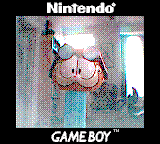
The World’s First color photograph taken with the Game Boy Camera!
More Pictures
October 31, 2001 - Okay, I know that they are not the most exciting subjects, but the following photos (plus the Pez Dispenser above) are the World’s First color photos taken with the Game Boy Camera. I just shot whatever was around to be used as test subjects.
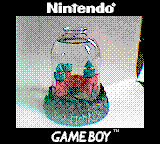

November 10, 2001 - My first outdoor attempts. First off, notice the vignetting in these images (the halo that seems to be around the pictures). This is caused by the camera itself reflecting in the Hot Mirror filter. I’ll have to use a black magic marker or something to make the GB Camera black so it doesn’t reflect (I think it wasn’t a problem indoors because the camera didn’t have such bright light on it). In the picture of the trees, the blue sky came out nicely peeking through the top. I’ll have to solve the halo problem before my next attempts.

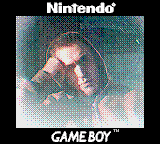
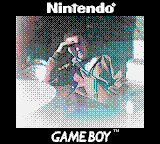
[That’s it. I never got the motivation to shoot any others in this series, as cheap color digital cameras became more prevalent, and the novelty of taking low quality color pictures with a cheap handheld device wore off].

Note: Do not play the game described below if you are in any potential danger of hurting yourself or others, or if you are near traffic, or anywhere that you aren’t positive it can be played safely. Play at your own risk.
That’s got you curious, huh? What’s the Sensory Deprivation game that’s so dangerous it requires a disclaimer? It’s something I found myself doing one day in college as I was walking across the busy campus and saw a blind student walking in the opposite direction with a walking cane. I wondered what it’s like to confidently walk around, even while unable to see. Blind people seem to do it okay. Could I?
I had my sunglasses on, so I figured nobody would notice if I suddenly closed my eyes. First I looked out at the ground ahead, the people walking around, and figured that if I just kept walking straight I would avoid all of them, and the lamp post. How many steps could I take before I had to open my eyes again? I decided to find out. Without changing my stride, I closed my eyes.
The answer was only around 6 steps. I had no confidence in my ability to navigate at all. I felt like at any second I would smash into something or someone. I must be veering one way or the other, right? When I opened my eyes, I realized that I had been walking straight after all and was actually doing pretty well. So I tried it again. After another 6 steps, I couldn’t bear it.
Why was I only able to take 6 steps? How many would I have been able to take if I’d had a walking cane before I freaked out about bumping into things? How long does it take the newly-blind to be able to get around confidently? Is it faster to learn with a cane, with a guide dog, or with echolocation?
I haven’t really played the game since then. Do I dare, here on the busy streets of Manhattan? Do I get bonus points if I play while wearing my iPod? How many steps can you take?

I just noticed this. On the north side of City Hall Park, right next to the Tweed Courthouse, gated off from the public, there’s a basketball hoop.

When was this installed? Does anyone use it? Is Mayor Bloomberg enjoying an occasional game of H-O-R-S-E when he’s got some downtime?

 Occasionally during downtime on a particularly slow photo shoot, I’ve played this game with my assistants. Everyone takes out a piece of paper, and numbers it from 1 to 50. Then you get 10 minutes to write down every state you can remember. Finally, you compare it to the master list and see who got the most answers. 10 minutes seems like more than enough time to remember a list of 50 items, right? And yet somehow I’ve never managed to get more than 48 of them.
Occasionally during downtime on a particularly slow photo shoot, I’ve played this game with my assistants. Everyone takes out a piece of paper, and numbers it from 1 to 50. Then you get 10 minutes to write down every state you can remember. Finally, you compare it to the master list and see who got the most answers. 10 minutes seems like more than enough time to remember a list of 50 items, right? And yet somehow I’ve never managed to get more than 48 of them.
Well, you don’t need to get out a piece of paper or a timer. I’ve put together an on-line version of this game. It’s a bit low-tech [see update below for high-tech version], but it works.
Have a go at it and then post your score in the comments.
Update: Thanks to reader Erik Wannebo, we now have a nifty interactive version which keeps track of your progress as you go and tallies your score for you. Check it out!

 The news lately has been full of reports of people’s Wii Remotes (aka “Wiimotes”) flying out of their hands and smashing into their television sets during heated gameplay with the new Nintendo Wii. Every time I hear reference to Flying Wiimotes, I keep thinking of that old Flying Toasters screen saver from the “After Dark” series that was so popular on people’s computers in the early 1990s.
The news lately has been full of reports of people’s Wii Remotes (aka “Wiimotes”) flying out of their hands and smashing into their television sets during heated gameplay with the new Nintendo Wii. Every time I hear reference to Flying Wiimotes, I keep thinking of that old Flying Toasters screen saver from the “After Dark” series that was so popular on people’s computers in the early 1990s.
So it got me thinking. Someone should combine the nostalgia of that old screen saver with this modern bit of technology history and make a Flying Wiimotes screen saver to commemorate this gaming snafu. It strikes me as a simple thing to do, but it’s just slightly beyond my programming expertise (or lack thereof). Anybody want to try their hand at it? There’s even an open source clone of the flying toasters screen saver as a starting point.

The upcoming Nintendo system, called the “Wii” (pronounced “We”), knows how you’re moving the controller. In fact, some games are controlled without pushing buttons at all, but by simply moving the controller. In a tennis game, for example, you literally swing the controller like a tennis racket, and your character on-screen mimics your move.
 So I’m thinking: Someone should come up with a game that uses a dumbbell accessory allowing you to attach the controller to your dumbbell. The game could have several component. There could be a section that’s just a normal workout, that just gives you training advice and lets you workout along with an on-screen trainer, and it tracks your progress because it knows how many reps and sets you’re doing by tracking your movement. And there could be actual games that incorporate your workout with the game. Maybe every time you raise the dumbbell over your head, you shoot an alien. Or punch an alien. Or pick an apple. Or something like that. I’m not a game designer, but I think it’s got potential.
So I’m thinking: Someone should come up with a game that uses a dumbbell accessory allowing you to attach the controller to your dumbbell. The game could have several component. There could be a section that’s just a normal workout, that just gives you training advice and lets you workout along with an on-screen trainer, and it tracks your progress because it knows how many reps and sets you’re doing by tracking your movement. And there could be actual games that incorporate your workout with the game. Maybe every time you raise the dumbbell over your head, you shoot an alien. Or punch an alien. Or pick an apple. Or something like that. I’m not a game designer, but I think it’s got potential.
I wouldn’t be surprised if something like this is already in the works. Maybe I should have foregone that gym membership in favor of the much less expensive Nintendo Wii.

The art in this airport food court reminded me of Super Mario Brothers:



I’ve had this design floating around my head for the past few days:
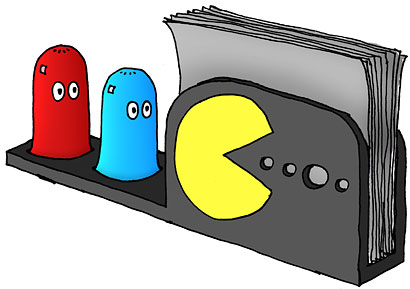

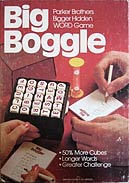 I’m really into Boggle these days. And I don’t mean that wussy 4x4 Boggle. No, I’m talkin’ about 5x5 Big Boggle. I know there are several on-line versions available, but nothing beats the fun of playing real people face-to-face, and the shake-shake sound of the cubes in the Boggle board. So I’ve been playing the real world game, and that’s when I noticed the Big Boggle game in progress on the Big Boggle box.
I’m really into Boggle these days. And I don’t mean that wussy 4x4 Boggle. No, I’m talkin’ about 5x5 Big Boggle. I know there are several on-line versions available, but nothing beats the fun of playing real people face-to-face, and the shake-shake sound of the cubes in the Boggle board. So I’ve been playing the real world game, and that’s when I noticed the Big Boggle game in progress on the Big Boggle box.
I think that must be the best Big Boggle tray ever. How carefully did they have to plan it? It’s hard to believe such a great tray is even possible by chance alone. There must be tons of great words on that tray. Take a look and see how many you can find. Remember: This isn’t the wussy edition, so to make things extra tough we’re not only disallowing 3 letter words, but 4 letter words as well.
So how many 5-letter or longer words can you find? For an added challenge, limit yourself to just 3 minutes.
I’ll start things off: PREDATING, STEAMERS, BEIGNETS…

And no fair using a computer program to figure it out. Just use your brain.

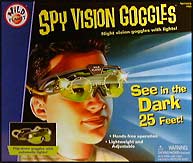 I saw this in a toy store the other day. I was just there to buy something for, um… Okay, sometimes I just like to go to the toy store. Anyway, I saw this toy. Spy Vision Goggles. Pretty cool, right? It says right there on the box: “See in the Dark 25 Feet!” How awesome is that? Man, we never had anything that cool when I was a kid. I can’t believe the technology for this stuff has gotten so cheap that they can — Hey, wait a minute.
I saw this in a toy store the other day. I was just there to buy something for, um… Okay, sometimes I just like to go to the toy store. Anyway, I saw this toy. Spy Vision Goggles. Pretty cool, right? It says right there on the box: “See in the Dark 25 Feet!” How awesome is that? Man, we never had anything that cool when I was a kid. I can’t believe the technology for this stuff has gotten so cheap that they can — Hey, wait a minute.
![]() “Night vision goggles with lights?” What does that mean? Here’s the fine print: “The Spy Vision Goggles can see in the dark up to 25 feet away with two powerful beams of light!” So basically they just have little flashlights on the sides. If you’re in the dark, you can turn on the light. Wow. That’s a far cry from seeing in the dark. In fact, that’s pretty much the opposite of seeing in the dark.
“Night vision goggles with lights?” What does that mean? Here’s the fine print: “The Spy Vision Goggles can see in the dark up to 25 feet away with two powerful beams of light!” So basically they just have little flashlights on the sides. If you’re in the dark, you can turn on the light. Wow. That’s a far cry from seeing in the dark. In fact, that’s pretty much the opposite of seeing in the dark.
When I was a kid, I had a pretty good imagination. But not that good.

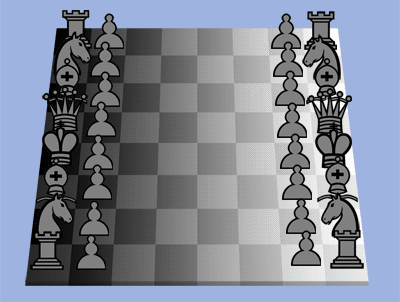
Chess is a game of war. So for those who disapprove of war, I’ve come up with the Pacifist Chess Set. The concept is illustrated above.
At first glance, it looks like you could play a legitimate game of chess with this set. But once you start playing you realize that you can’t play for very long — at least not very easily. As you play, and your pieces get closer to your opponent’s pieces, it becomes apparent that one side’s pieces are indistinguishable from the other side’s pieces. They are all the same color.
It’s not really a functional chess set. It’s more of an art or conversation piece. It makes the statement that, no matter what side of the battle we’re on, we have in common that we are all human.
[I got this idea while wandering through the Imagery of Chess Revisited exhibit at the Noguchi Museum in Queens. The exhibit is only around for two more weeks, but if you get a chance I highly recommend a visit. It features works by Man Ray, Marcel Duchamp, Max Ernst, Alexander Calder, and others. A book is also available, in case you miss the show.]
